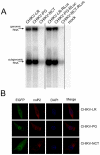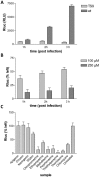Inhibitors of alphavirus entry and replication identified with a stable Chikungunya replicon cell line and virus-based assays
- PMID: 22205980
- PMCID: PMC3242765
- DOI: 10.1371/journal.pone.0028923
Inhibitors of alphavirus entry and replication identified with a stable Chikungunya replicon cell line and virus-based assays
Abstract
Chikungunya virus (CHIKV), an alphavirus, has recently caused epidemic outbreaks and is therefore considered a re-emerging pathogen for which no effective treatment is available. In this study, a CHIKV replicon containing the virus replicase proteins together with puromycin acetyltransferase, EGFP and Renilla luciferase marker genes was constructed. The replicon was transfected into BHK cells to yield a stable cell line. A non-cytopathic phenotype was achieved by a Pro718 to Gly substitution and a five amino acid insertion within non-structural protein 2 (nsP2), obtained through selection for stable growth. Characterization of the replicon cell line by Northern blotting analysis revealed reduced levels of viral RNA synthesis. The CHIKV replicon cell line was validated for antiviral screening in 96-well format and used for a focused screen of 356 compounds (natural compounds and clinically approved drugs). The 5,7-dihydroxyflavones apigenin, chrysin, naringenin and silybin were found to suppress activities of EGFP and Rluc marker genes expressed by the CHIKV replicon. In a concomitant screen against Semliki Forest virus (SFV), their anti-alphaviral activity was confirmed and several additional inhibitors of SFV with IC₅₀ values between 0.4 and 24 µM were identified. Chlorpromazine and five other compounds with a 10H-phenothiazinyl structure were shown to inhibit SFV entry using a novel entry assay based on a temperature-sensitive SFV mutant. These compounds also reduced SFV and Sindbis virus-induced cytopathic effect and inhibited SFV virion production in virus yield experiments. Finally, antiviral effects of selected compounds were confirmed using infectious CHIKV. In summary, the presented approach for discovering alphaviral inhibitors enabled us to identify potential lead structures for the development of alphavirus entry and replication phase inhibitors as well as demonstrated the usefulness of CHIKV replicon and SFV as biosafe surrogate models for anti-CHIKV screening.
Conflict of interest statement
Figures



References
-
- Gubler DJ. The global emergence/resurgence of arboviral diseases as public health problems. Arch Med Res. 2002;33:330–342. - PubMed
-
- Pialoux G, Gauzere BA, Jaureguiberry S, Strobel M. Chikungunya, an epidemic arbovirosis. Lancet Infect Dis. 2007;7:319–327. - PubMed
-
- Powers AM, Logue CH. Changing patterns of Chikungunya virus: re-emergence of a zoonotic arbovirus. J Gen Virol. 2007;88:2363–2377. - PubMed
Publication types
MeSH terms
Substances
LinkOut - more resources
Full Text Sources
Other Literature Sources
Medical

